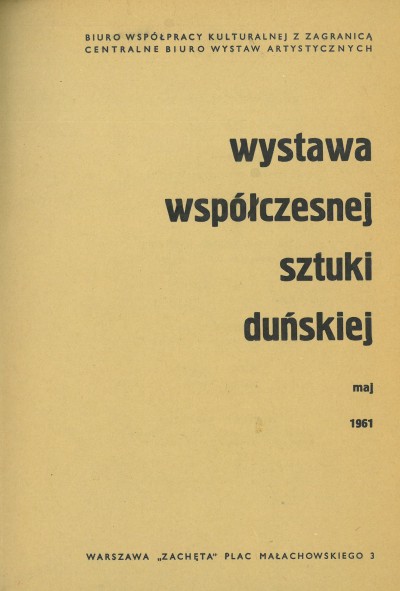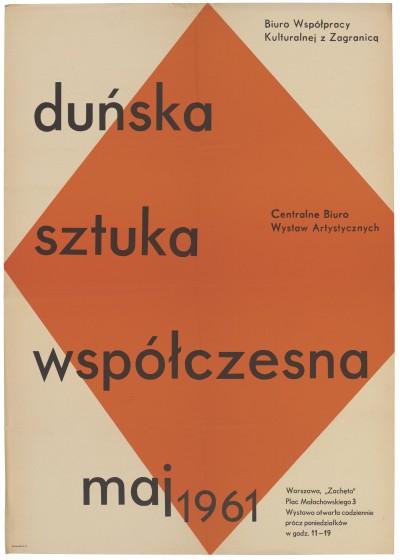Exhibition of Contemporary Danish Art
04.05 – 21.05.1961 Exhibition of Contemporary Danish Art
Zachęta Central Bureau of Art Exhibitions (CBWA)
organiser: Central Bureau of Art Exhibitions, International Cultural Relations Bureau
commissioner: Jørn Rubow, director of Statens Museum for Kunst (National Gallery of Denmark) in Copenhagen
poster design: Henryk Tomaszewski
number of artists: 30
number of exhibits: 208
attendance: 3,218 (Rocznik CBWA [CBWA Annual])
The exhibition, held under the auspices of the foreign ministers of both countries, was one of the comprehensive reviews of the art of a capitalistic country that rarely took place in the 1960s. Although the exhibition was a response to the show of Polish abstraction organised in Copenhagen in 1959, it did not limit itself (contrary to the title) to the latest art. Quite the opposite, the event constituted a typical promotional product of the Danes, who tried to create an image of the culture of their country, unknown abroad (it was a touring exhibition that had previously visited three towns in Yugoslavia).
Put together by the team of the most important state museum in Denmark, Statens Museum for Kunst in Copenhagen (with the catalogue containing a short introduction by the director Jørn Rubow), it altogether consisted 208 exhibits: 19th-century painting (including of the most famous symbolists: Vilhelm Hammershøi, Laurits A. Ring, Jens Ferdinand Willumsen), painting and sculpture of the interwar period, a wide selection of contemporary artists (painting and sculpture; there was only one contemporary graphic artist, Palle Nielsen, represented by a large series of 53 woodcuts, Orpheus and Eurydice, awarded at the Venice Biennale a year before).
Photo prints (there were 35 of them) depicted, in a very peculiar combination, old Danish art: from the Middle Ages (10 photos of runestones, Romanesque churches and Gothic frescoes) to the sculptures of Berthel Thorvaldsen, several sculptors of the 19th and the beginning of the 20th century and paintings of the ‘Golden Age’ (the turn of the 18th and 19th century). Thus, no attempt was made to conduct a historical review of Danish art but, instead, the examples chosen as the most significant contribution to European culture were displayed. On the other hand, the selection of contemporary artists gave the appearances of a broader panorama of various trends, as if the organisers wanted to demonstrate the awareness and presence of numerous main movements of world art in Denmark. The exhibition catalogue reproduces only a few works of the 20th-century artists.
Pieces by two artists of world renown were showcased: Richard Mortensen (as many as 7 pictures), an abstract painter who exhibited in Paris and was promoted there by, among others, the famous Galerie Denise René, and sculptor Robert Jacobsen (3 abstract iron constructions), associated with the same Parisian gallery. The show featured also locally recognised, but almost unheard-of in Europe artists, for example, Vilhelm Lundstrøm, a cubist painter, Jens Søndergaard, an expressionist painter drawing on Edvard Munch, Poul Bjørklund, an interwar realist painter, and Erik Thommesen, a sculptor who had represented Denmark at the Venice Biennale in 1956.
The most acclaimed phenomenon of contemporary Danish art of that time, the avant-garde movement CoBrA, was shown very perfunctorily, only in the works of Henry Heerup and Carl Henning Pedersen. Asger Jorn and Egill Jacobsen, the most famous members of CoBrA, were notably absent from the exhibition. Was it because the Danes, while preparing their show for Poland and Yugoslavia, wanted to avoid showing rebels (though, after all, left-leaning ones)? The Warsaw public had already had an opportunity to see a few works by the Dutch members of the CoBrA group at the National Museum in the spring of 1960: these were the pictures of Karel Appel and Corneille, which closed the review of Dutch painting from Vincent van Gogh and Piet Mondrian onwards. Apart from that, Corneille was also presented at the international exhibition of the Phases group at the Kraków Krzysztofory Gallery in 1959. Three pictures by Jorn would not appear in Warsaw until 1966, at the Contemporary Tendencies show, which presented paintings from the collections of Stedelijk Museum in Amsterdam and Van Abbe Museum in Eindhoven.
It was the CoBrA participants who were noticed in the two most comprehensive and most insightful reviews of the Zachęta exhibition. Heerup was perceived as the greatest personality of the event by Andrzej Osęka (and it seems that the verdict stood the test of time),[1] while Pedersen was described by Ignacy Witz as ‘the only spontaneous talent for painting here’.[2]
However, there was a tinge of condescension toward the art of a ‘small country’ in the accounts of the Warsaw press. As the Sztandar Młodych reviewer wrote, ‘the contemporary Danish fine arts have developed in the atmosphere of intense contacts with the art of the leading European centres’.[3] Trybuna Ludu pointed out that the reproductions of old art on display allowed ‘the historical continuity of Danish art to be demonstrated’.[4] Similarly, Joanna Guze emphasised ‘historical and stylistic regularities’ and the specific Danish element in the ‘realities and landscape’.[5] She stressed French influences on the contemporary artists, but also their inclination towards the classical order which held back the march of art informel in Denmark. Osęka, on the other hand, highlighted the mark of Flemish, German and Scandinavian expressionisms noticeable in the works of many Danish artists. Ewa Garztecka underscored, possibly with the Polish subtext, the absence of the colour tendency in Danish painting.[6] The exhibition was also covered by Sławomir Bołdok and, quite critically, Stanisław Ledóchowski.[7] Henryk Tomaszewski designed the poster. Parallel to the discussed event, there was a retrospective exhibition of Aleksander Rafałowski’s works at Zachęta.
The idea of a historical (although highly selective) show of the history of Danish art, compared with other exhibitions held in Warsaw at that time, seems unique. As a general rule, such panoramas embraced only the ‘modern’ period: thus Belgians were presented in 1957, 70 Years of Dutch Painting (at the National Museum in Warsaw in 1960), the Swiss, starting from Ferdinand Hodler (in the same place in 1965). A great exhibition of Mexican art, staged the same year at the National Museum in Warsaw, offered an interesting context for the primitive trend in the most recent Danish art.
Large review shows of contemporary Western art were scarce in the Gomułka period in Warsaw. Instead of Americans and Britons (passed over for obvious reasons), artists from countries with a strong position of the communist parties — Canadians, the French and Italians — were presented behind the Iron Curtain. After the bold show of graphic arts from West Germany in 1956, it was not until 1968 that artists from the Federal Republic of Germany returned (that year, there was an exhibition at Zachęta featuring only one group of ‘progressive’ artists from the Tendenzen group). In this situation, the presence of Scandinavians appears serious and quite regular. Contemporary Danish art was shown at Zachęta again in 1968, and Egill Jacobsen had his solo exhibition there in 1965. A big exhibition of Swedish art took place in 1966. As it appears, the cooperation with the neutral Scandinavian countries was politically less ‘dangerous’ . . . Three months after the Danish exhibition at Zachęta, the Berlin Wall was erected and international tensions started to rise.
Andrzej Pieńkos
Institute of Art History of the University of Warsaw
This compilation was prepared as part of the National Programme for the Development of Humanities of the Polish Minister of Science and Higher Education — research project The History of Exhibitions at Zachęta — Central Bureau of Art Exhibitions in 1949–1970 (no. 0086/NPRH3/H11/82/2016) conducted by the Institute of Art History of the University of Warsaw in collaboration with Zachęta — National Gallery of Art.
Bibliography
Catalogues:
- Wystawa współczesnej sztuki duńskiej. introduction: Jørn Rubow. Warsaw: Centralne Biuro Wystaw Artystycznych, 1961
- Rocznik CBWA 1959–1960–1961. Warsaw: Centralne Biuro Wystaw Artystycznych, [1962], pp. 55–56
Source texts:
- B g. ‘Kronika’. Życie Literackie, no. 23, 1961
- Bołdok, Sławomir. ‘Wystawa sztuki duńskiej’. Przegląd Artystyczny, no. 3, 1961
- (bor). ‘Wystawa’. Kulisy, no. 21, 1961
- dasz. ‘Sztuka duńska w Polsce’. Sztandar Młodych, no. 107, 1961
- ega. ‘Sztuka współczesna Danii — Na wystawie’. Trybuna Ludu, no. 122, 1961
- (g). ‘Mieszanka zagraniczna’. Kurier Polski, no. 118, 1961
- Garztecka, Ewa. ‘Współczesna sztuka duńska w Zachęcie’, Trybuna Ludu, no. 133, 1961
- (grt). ‘Malarstwo, rzeźba, grafika na warszawskich wystawach’. Express Wieczorny, no. 122, 1961
- Guze, Joanna. ‘Wystawa sztuki duńskiej’. Świat, no. 22, 1961
- J.B. ‘Sztywna geometria . . .?’. Zarzewie, no. 22, 1961
- Ledóchowski, Stanisław. ‘Niebo jest czarne’. Nowa Kultura, no. 22, 1961
- Osęka, Andrzej. ‘Duńczycy — Biennale grafiki’. Przegląd Kulturalny, no. 19, 1961
- Witz, Ignacy. ‘Przechadzki po warszawskich wystawach’. Życie Warszawy, no. 118, 1961
Press mentions:
- Express Wieczorny, no. 108, 1961
- Polityka, no. 19, 1961
- Słowo Powszechne, no. 109, 1961
- Stolica, no. 21, 1961
- Sztandar Młodych, no. 209, 1961
- Świat, no. 20, 1961
- Trybuna Mazowiecka, no. 108, 1961
- Życie Warszawy, no. 106, 1961
Artists
Painters of the late 19th and early 20th centuries: Niels Bjerre, Poul S. Christiansen, Vilhelm Hammershøi, Peter Hansen, Harald Giersing, Laurits A. Ring, Edvard Weie, Jens Ferdinand Willumsen
Contemporary artists: Poul Bjørklund, Ebba Carstensen, Frede Christoffersen, Poul Ekelund, Svend Wiig Hansen, Laurtiz Hartz, Erik Hoppe, Vilhelm Lundstrøm, Richard Mortensen, Carl Henning Pedersen, Jens Søndergaard
Contemporary sculptors: Moggens Bøggild, Gofftred Eickhoff, Adam Fischer, Jørgen Gudmundsen-Holmgreen, Henry Heerup, Robert Jacobsen, Søren Georg Jensen, Astrid Noack, Ulf Rasmussen, Erik Thommesen
Graphic arts: Palle Nielsen
[1] Andrzej Osęka, ‘Duńczycy – Biennale grafiki’, Przegląd Kulturalny, no. 19, 11 May 1961.
[2] Ignacy Witz, ‘Przechadzki po warszawskich wystawach’, Życie Warszawy, no. 118, 1961.
[3] dasz., ‘Sztuka duńska w Polsce’, Sztandar Młodych, no. 107, 5 May 1961.
[4] ega, ‘Sztuka współczesna Danii – Na wystawie’, Trybuna Ludu, no. 122, 5 May 1961.
5] Joanna Guze, ‘Wystawa sztuki duńskiej’, Świat, no. 22, 28 May 1961.
[6] Ewa Garztecka, ‘Współczesna sztuka duńska w Zachęcie’, Trybuna Ludu, no. 133, 16 May 1961.
[7] Sławomir Bołdok, ‘Wystawa sztuki duńskiej’, Przegląd Artystyczny, no. 3, 1961; Stanisław Ledóchowski, ‘Niebo jest czarne’, Nowa Kultura, no. 22, 1961.
-
02.04 – 21.04.1968Danish Contemporary Art
Contrary to the large Danish art exhibition organised by the Central Bureau of Art Exhibitions in 1961, this exhibition covered only the works of the young generation of Danish artists. Its context, as well as the source and authorship of the concept remain elusive.
Zachęta Central Bureau of Art Exhibitions (CBWA)CBWA
Exhibition of Contemporary Danish Art
04.05 – 21.05.1961
Zachęta Central Bureau of Art Exhibitions (CBWA)
pl. Małachowskiego 3, 00-916 Warsaw
See on the map

